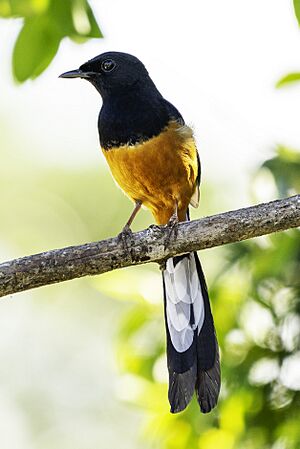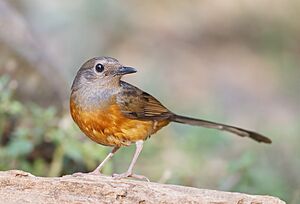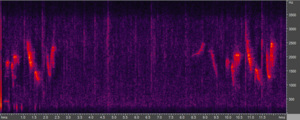White-rumped shama facts for kids
Quick facts for kids White-rumped shama |
|
|---|---|
 |
|
| Male | |
 |
|
| Female | |
| Conservation status | |
| Scientific classification | |
| Genus: |
Copsychus
|
| Species: |
malabaricus
|
| Synonyms | |
|
Kittacincla macrura |
|
The white-rumped shama (Copsychus malabaricus) is a small passerine bird. It belongs to the family Muscicapidae, which includes flycatchers and robins. These birds live naturally in thick forests across the Indian subcontinent and Southeast Asia. Many people enjoy their beautiful songs, so they are often kept as pet birds. Because of this, they have been introduced to other places around the world.
Contents
About the White-Rumped Shama
This bird was once thought to be part of the thrush family. That's why it was sometimes called the "white-rumped shama thrush." But now, scientists have learned more about its family tree.
Different Types of Shamas
There are several different types, or "subspecies," of the white-rumped shama. They live in various parts of Asia. For example, one type lives in Sri Lanka, and another in northern India. Some types found on islands, like the Andaman shama and the white-crowned shama, are now often considered completely separate species.
What Does a Shama Look Like?
White-rumped shamas usually weigh about 28 to 34 grams. They are around 23 to 28 centimeters long.
Male shamas are quite striking. They have shiny black feathers with a reddish-brown belly. You can also see white feathers on their lower back and outer tail. Females look a bit different. They are more greyish-brown and are usually a little smaller than the males. Both male and female shamas have a black beak and pink feet.
Young shamas, called juveniles, look similar to the females. They are greyish-brown, but their chest often has blotchy or spotted patterns.
Shama Behavior and Life
Territory and Reproduction
White-rumped shamas are shy birds. They are most active around dawn and dusk. They are also very protective of their space. During the breeding season, a male and female share a territory. Males will guard this area, which is usually about the size of a small park. When they are not breeding, males and females might have separate territories.
In South Asia, these birds usually breed from January to September. The busiest time is from April to June. The female lays about four or five eggs in a nest. She often builds her nest inside a hollow tree.
Courtship Rituals
During courtship, the male shama tries to impress the female. He will chase her and then land above her. He makes a loud, shrill call and fans out his tail feathers. Both birds might then fly up and down in a wavy pattern. If the female is not interested, she might open her mouth to show him she's not pleased!
Nesting and Young Birds
The female shama builds the nest all by herself. The male stays nearby to guard her. Nests are usually made from roots, leaves, ferns, and small stems. The eggs hatch after about 12 to 15 days. The baby birds stay in the nest for about 12 days. Both parents feed the young, but only the female sits on the eggs and keeps the babies warm. The eggs are white to light blue, with brown spots. They are about 18 to 23 millimeters in size.
What Do Shamas Eat?
In the wild, white-rumped shamas mainly eat insects. If they are kept as pets, they might be fed a special diet. This diet can include cooked, dried beans mixed with egg yolk and raw meat.
Their Amazing Voice
The white-rumped shama is famous for its rich and beautiful song. This is why they are so popular as pet birds in South Asia and parts of Southeast Asia. Their song is loud and clear, with many different sounds. They are also good at copying the songs of other birds.
Shamas also make a "Tck" sound. They use this call when they are alarmed or when they are looking for food.
Did you know that one of the very first recordings of a bird song was of a white-rumped shama? This happened in 1889! A man named Ludwig Karl Koch recorded the song of a pet shama in Germany using an old Edison wax cylinder.
Where Do Shamas Live?
White-rumped shamas are originally from the scrublands and forests of South Asia and Southeast Asia. However, they have been brought to other places by people. For example, they were introduced to the Hawaiian islands of Kauai in 1931 and Oahu in 1940. Because they are popular cage birds, many have escaped and started living in the wild in new areas.
In Taiwan, they are considered an invasive species. This means they are not native to the area and can cause problems. They eat local insects and can be aggressive towards native bird species.
In Asia, shamas prefer to live in thick bushes, especially in bamboo forests. In Hawaii, you can often find them in valley forests or on the ridges of the southern Koolau mountains. They like to nest in the undergrowth or low trees of lowland forests.
Gallery






